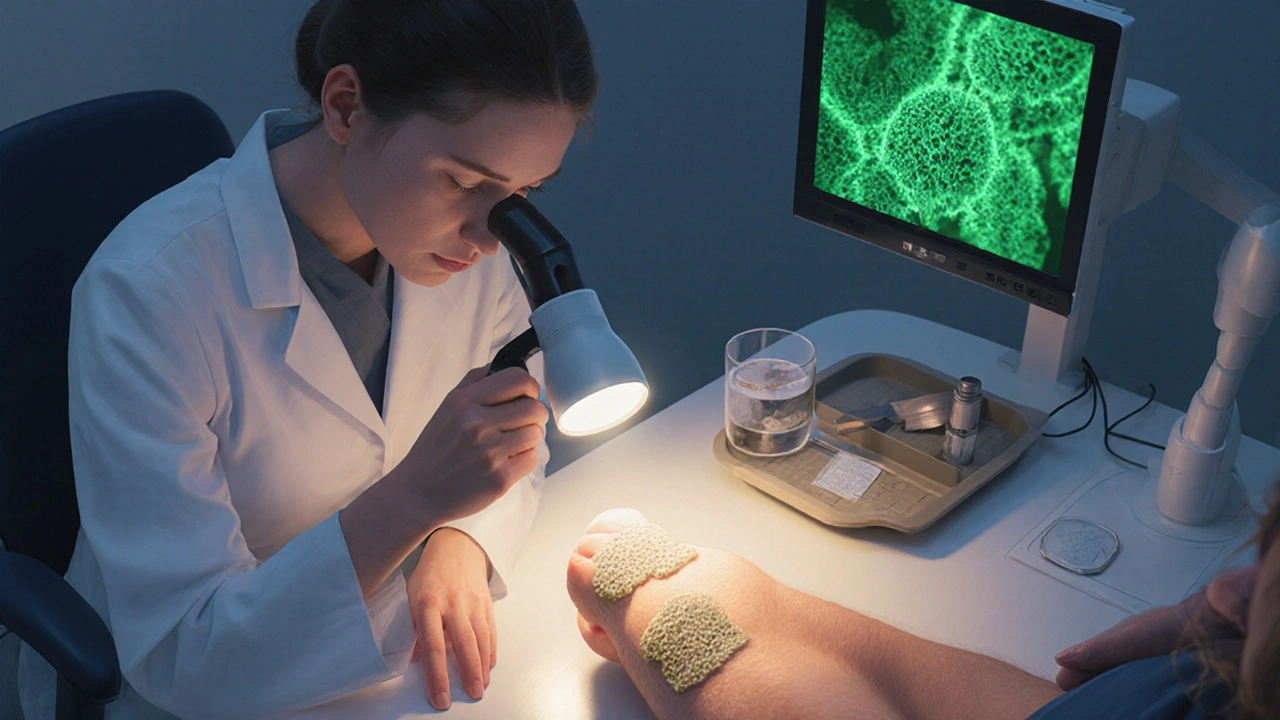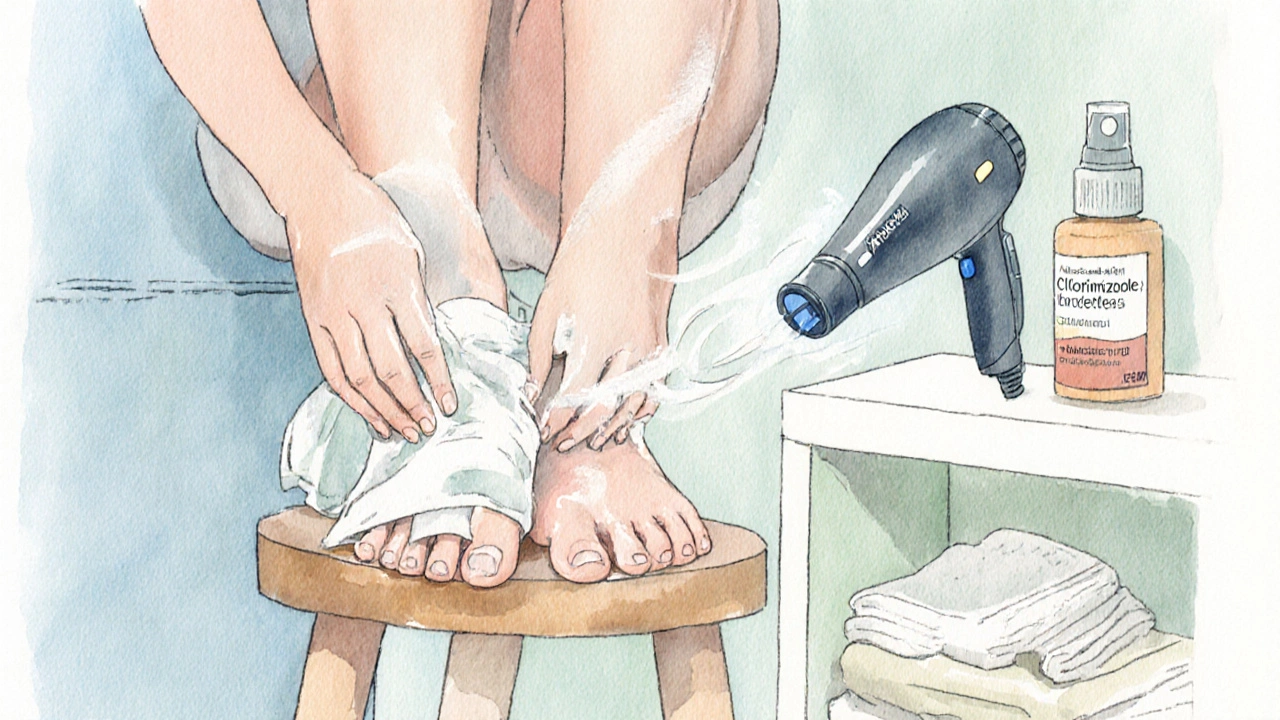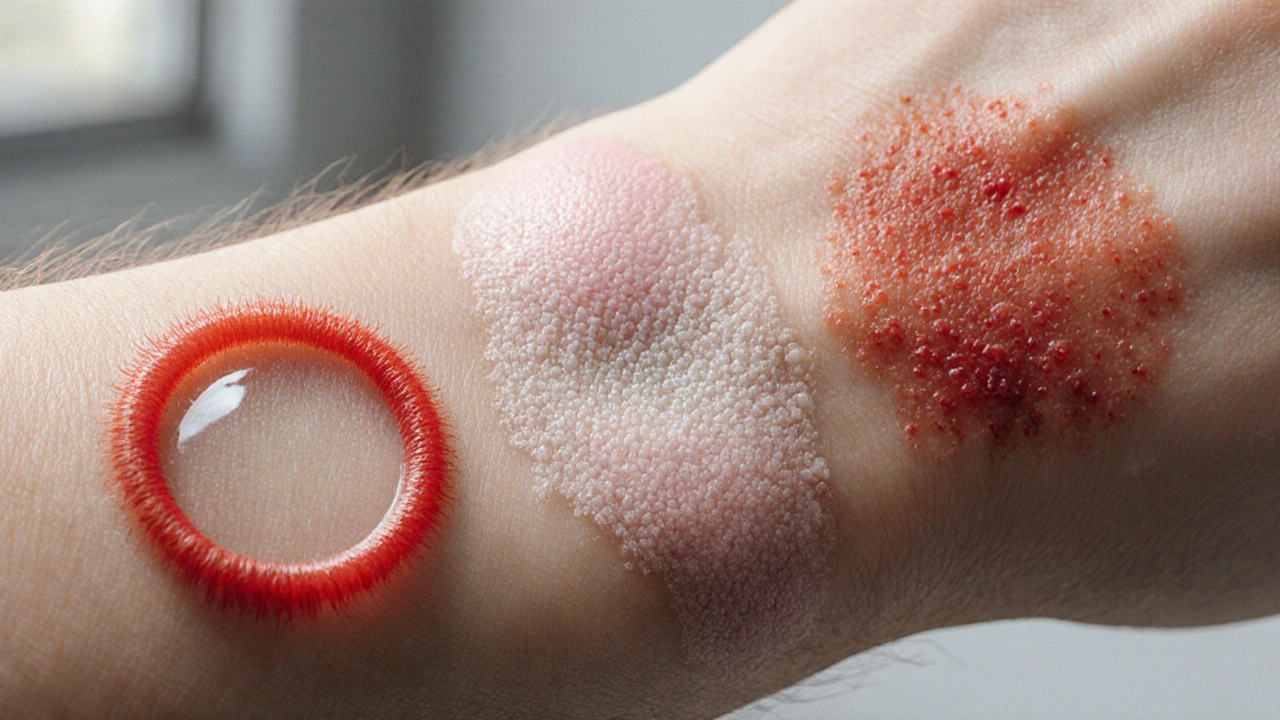Fungal Skin Condition Identifier
Potential Fungal Condition:
Tinea Corporis
Ringworm-like red rings with clear centers
Tinea Versicolor
White, pink, or brown patches that fade with sun
Candidiasis
Bright red, moist lesions with satellite spots
When a patch on your skin suddenly changes color, you might wonder if it’s just a harmless irritation or something that needs professional care. Fungal skin discoloration isn’t just a cosmetic issue-it can signal an infection that, if left untreated, spreads or worsens. Below is a quick snapshot of what to watch for:
- Sudden color shift (red, brown, white, or yellow)
- Itching, burning, or flaky texture
- Rapid spread to nearby areas
- Persistent symptoms beyond two weeks
If any of these ring a bell, it’s time to see a dermatologist.
What Exactly Is Fungal Skin Discoloration?
Fungal skin discoloration is a skin condition caused by an overgrowth of fungi that alters the pigment and texture of the affected area. Common culprits include tinea species, candida, and Malassezia. The fungi thrive in warm, moist environments, which is why you often see them on the feet, groin, or under a shirt that traps sweat.
How Do You Spot the Difference Between Normal Skin Changes and a Fungus?
It’s easy to mistake a sun tan or a temporary bruise for a fungal issue. Here are three clues that point specifically to a fungal infection:
- Border pattern: Fungal spots usually have a raised, scaly edge that spreads outward, unlike a uniform sunburn.
- Texture: You’ll feel a fine scaling or “sandpaper” feeling, especially after a shower.
- Response to heat: Warmth often makes the area itchier, while a cool compress provides temporary relief.
If you notice these signs, the next step is figuring out which fungus you’re dealing with.
Common Fungal Culprits and Their Signature Looks
Not all fungi look the same. Below is a quick guide to the most frequently seen types and what they typically do to your skin.
| Condition | Typical Color Change | Common Location | Usual Treatment |
|---|---|---|---|
| Tinea corporis (ringworm) | Red or pink ring with clearer center | Arms, trunk, face | Topical antifungal cream (e.g., clotrimazole) |
| Tinea versicolor (pityriasis) | White, pink, or brown patches that fade with sun | Upper trunk, shoulders | Topical selenium sulfide or oral azole |
| Candidiasis | Bright red, moist, often with satellite lesions | Groin, skin folds, under nails | Topical azoles; oral fluconazole for extensive cases |
| Tinea pedis (athlete’s foot) | White scaling between toes, sometimes yellow | Between toes, soles | Topical terbinafine or spray antifungal |
| Tinea capitis (scalp ringworm) | Scaly, hairless patches, sometimes black dots | Scalp of children | Oral griseofulvin or terbinafine |

When to Pick Up the Phone and Call a Dermatologist
Even if you’re comfortable treating a minor rash at home, certain red flags mean a specialist’s eye is essential:
- Spread beyond the original spot within a few days.
- Persistent itching or burning that disrupts sleep.
- Signs of secondary infection-pus, increased warmth, or swelling.
- Uncertainty about the cause-if you’ve tried an over‑the‑counter cream without improvement.
- Underlying health conditions such as diabetes or immunosuppression, which can turn a simple fungus into a serious problem.
A dermatologist can confirm the diagnosis with a quick skin scraping, a Wood’s lamp exam, or, in rare cases, a skin biopsy. Early, accurate identification often shortens treatment time dramatically.
What to Expect During a Dermatology Visit
Walk into the clinic and you’ll typically go through three steps:
- History review: The doctor asks about recent travel, sweaty workouts, humidity exposure, and any previous skin issues.
- Visual exam: Using a magnifying lamp, the clinician observes texture, border, and any scaling patterns.
- Laboratory confirmation (if needed): A gentle skin scrape is placed on a slide and examined under a microscope. Some offices use a Wood’s lamp, which makes certain fungi glow bright green.
Most visits end with a prescription for a topical agent, plus tips on keeping the area dry and clean. If the infection is widespread, you might get a short course of oral antifungal medication.
Self‑Care Tips While You Wait for Your Appointment
If you can’t see a dermatologist right away, these home measures can keep the fungus in check:
- Keep it dry: After showering, pat the area completely dry. Use a hairdryer on a cool setting for hard‑to‑reach spots.
- Wear breathable fabrics: Cotton or moisture‑wicking athletic wear reduces sweat buildup.
- Apply over‑the‑counter antifungal cream: Look for clotrimazole 1% or terbinafine 1%. Apply twice daily for at least two weeks, even if the rash seems gone.
- Avoid sharing personal items: Towels, socks, and shoes can spread the fungus to family members.
- Clean your environment: Wash bedding and clothing in hot water (≥60°C) and use a disinfectant spray on bathroom floors.
These steps aren’t a cure, but they can prevent the infection from getting worse while you schedule a professional visit.
Potential Complications of Ignoring Fungal Discoloration
Leaving a fungal infection untreated can lead to a few uncomfortable outcomes:
- Chronic skin changes: Persistent scaling can cause thickened skin (lichenification) that’s harder to treat.
- Secondary bacterial infection: Scratching breaks the skin barrier, inviting bacteria like Staphylococcus aureus.
- Spread to other body parts: A toe infection can travel to the groin (tinea cruris) or even the scalp.
- Systemic involvement: In people with weakened immune systems, fungi can enter the bloodstream, leading to serious health risks.
That’s why early diagnosis by a dermatologist isn’t just about aesthetics-it’s about keeping your skin healthy long‑term.

Frequently Asked Questions
Can I tell the difference between a fungal rash and eczema?
Eczema usually appears as dry, itchy patches that may weep or become thick over time, while fungal rashes often have a defined, scaly border and may change color when exposed to heat. A quick skin scrape by a dermatologist can confirm the cause.
Do over‑the‑counter creams work for all fungal skin discolorations?
Most mild cases respond well to OTC creams like clotrimazole or terbinafine. However, infections that cover large areas, involve the scalp, or affect immunocompromised patients often need prescription-strength topical agents or oral medication.
How long does treatment usually take?
Topical treatments typically require 2-4 weeks of consistent use, even after the rash looks better. Oral antifungals for extensive infections may be prescribed for 1-3 weeks, depending on severity.
Is it safe to use home remedies like tea tree oil?
Tea tree oil has modest antifungal properties, but concentrations vary, and it can irritate sensitive skin. It’s best to use proven OTC medications first and discuss any alternative treatments with your dermatologist.
Can fungal skin discoloration return after treatment?
Recurrence is common if the underlying conditions-like excessive sweating, tight clothing, or a warm environment-aren’t addressed. Keeping the skin dry, rotating footwear, and using antifungal powders in high‑risk areas reduce the chance of a comeback.

Garrett Williams
October 1, 2025 AT 17:04Great guide totally useful
joba alex
October 7, 2025 AT 11:57i dont think this tool is all that helpful its more like a gimmick you cant rely on for real diagnosis you need a lab swab per se the whole UI feels like a beta version of a medical textbook
Rene Lacey
October 13, 2025 AT 06:51Reading through the article feels like opening a small philosophical treatise on the skin as a living canvas of our internal ecosystems. The very notion that a discoloration might be a messenger of hidden fungal activity invites contemplation of the unseen battles waged beneath our epidermis. One could argue that the skin, much like the mind, reflects the equilibrium-or lack thereof-between host and microbe. When we notice a red ring, it is not merely a cosmetic annoyance but a signal of an ecological disturbance. This perspective aligns with the larger philosophical view that health is a state of harmony, and disease a symptom of discord. The author’s breakdown of symptoms cleverly maps the topography of this discord, offering a map for the curious traveler. Yet, we must ask whether such categorization reduces the complex interplay to a simplistic checklist. In the spirit of phenomenology, the lived experience of itching and burning carries meaning beyond the clinical label. The article’s practical advice about dryness and breathable fabrics touches upon the virtue of self‑care as an ethical practice. Moreover, the emphasis on specialist consultation reminds us of the humility required when confronting the limits of our own knowledge. It is a reminder that expertise is not arrogance but a collective resource. The narrative also subtly critiques the modern habit of quick fixes, urging patience over the two‑week regimen. In doing so, it mirrors the ancient Stoic principle of enduring discomfort for long‑term flourishing. The mention of secondary bacterial infection serves as a cautionary tale about cascading consequences, much like a domino effect in societal systems. The discussion of immunocompromised hosts extends the conversation to social vulnerability and access to care. Finally, the concluding FAQ section embodies the Socratic method, anticipating doubts and answering them before they arise. All in all, the piece is a microcosm of the broader dialogue between body, mind, and environment, inviting readers to become both observers and participants in their own health narrative.
johnson mose
October 19, 2025 AT 01:44Hey folks, just wanted to add a quick tip – when you’re dealing with something like tinea pedis, keep your socks dry and change them at least twice a day. It might sound simple but the moisture trap is the biggest enemy. Also, a little foot powder after shower can make a world of difference. If you can, let your shoes breathe – slip them on a rack instead of a dark closet. And remember, the OTC creams work best when you keep the area clean and let the medication sit for the full two weeks, even if the rash looks gone.
Charmaine De Castro
October 24, 2025 AT 20:37Thanks for the thorough rundown! I’ve had a stubborn ringworm on my arm for months and finally tried the clotrimazole cream after reading this. Kept the area dry, applied twice daily, and within ten days the border started to fade. It’s amazing how a simple routine can make such a big difference. Keep spreading the word, it really helps people who are stuck in the trial‑and‑error loop.
Bernard Valentinetti
October 30, 2025 AT 14:31Wow!!! This post is absolutely stellar!!!; I love the detail; the way you broke down each fungus is just brilliant!!! 😊👍✨
Kenneth Obukwelu
November 5, 2025 AT 09:24What a fantastic collage of cultural and medical insight! From the ancient practice of using herbal poultices to modern antifungal agents, it’s clear that skin health bridges tradition and science. I’d love to see more on how diet and climate intersect with these infections – perhaps a future post?
Josephine hellen
November 11, 2025 AT 04:17Reading this really lifted my spirits – it’s reassuring to know that even the most persistent discoloration can be tackled with the right approach. I’ve struggled with tinea versicolor for years, and after following the suggested selenium sulfide regimen, my skin finally started to calm down. The key, as you highlighted, is consistency and patience; don’t give up after a few days of improvement. Also, keeping a journal of triggers – like humidity or certain fabrics – can help you anticipate flare‑ups. Remember, every small step you take toward dryness and proper hygiene adds up, turning a vague worry into a manageable routine. Your encouragement makes the journey feel less lonely, and that community vibe is priceless. Keep the optimism flowing, and thank you for sharing such a comprehensive guide!
Ria M
November 16, 2025 AT 23:11Ah, the drama of a skin patch that refuses to be ignored! One moment you’re basking in the sun, the next you spot a rogue speck of color daring to defy the norm. It’s as if the fungus itself stages a theatrical rebellion, demanding attention with every itch and flare. Yet, beneath the melodrama lies a simple truth: fungi thrive where we give them cozy, moist quarters. So, let us be the directors of this microscopic play, casting out the damp set pieces and spotlighting dryness. In the grand saga of epidermal health, every brush with a candid candida episode is a plot twist we can rewrite with proper care.
Michelle Tran
November 22, 2025 AT 18:04meh 😂😂
Delilah Jones
November 28, 2025 AT 12:57Look, if you’re still using that old tar‑based cream for fungal infections, you’re just digging yourself deeper. Switch to a proven azole and stop the guessing game.
Pastor Ken Kook
December 4, 2025 AT 07:51Totally agree with you – the old stuff just isn’t cutting it 😤
Northern Lass
December 10, 2025 AT 02:44It is most curious indeed that the author, in an ostensibly scientific exposition, elects to employ layman terminology whilst claiming comprehensive authority on the subject. One might wonder whether such stylistic concessions not betray an underlying paucity of genuine expertise, perhaps indicative of a broader trend wherein popular health discourse is diluted for mass consumption, to the detriment of accurate knowledge dissemination.